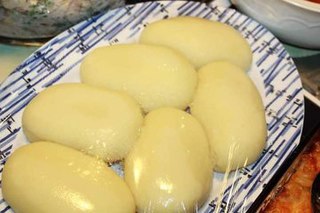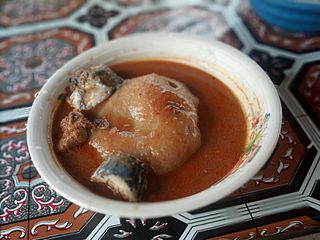
Cooking bananas are banana cultivars in the genus Musa whose fruits are generally used in cooking. They may be eaten ripe or unripe and are generally starchy. Many cooking bananas are referred to as plantains or green bananas. In botanical usage, the term "plantain" is used only for true plantains, while other starchy cultivars used for cooking are called "cooking bananas". True plantains are cooking cultivars belonging to the AAB group, while cooking bananas are any cooking cultivar belonging to the AAB, AAA, ABB, or BBB groups. The currently accepted scientific name for all such cultivars in these groups is Musa × paradisiaca. Fe'i bananas from the Pacific Islands are often eaten roasted or boiled, and are thus informally referred to as "mountain plantains", but they do not belong to any of the species from which all modern banana cultivars are descended.

The Kwa languages, often specified as New Kwa, are a proposed but as-yet-undemonstrated family of languages spoken in the south-eastern part of Ivory Coast, across southern Ghana, and in central Togo. The Kwa family belongs to the Niger-Congo phylum. The name was introduced 1895 by Gottlob Krause and derives from the word for 'people' (Kwa) in many of these languages, as illustrated by Akan names. This branch consists of around 50 different languages spoken by about 25 million people. Some of the largest Kwa languages are Ewe, Akan and Baule.

Ghana is a country of 28.21 million people and many native groups, such as:

Fufu is a pounded meal found in West African cuisine. It is a Twi word that originates from the Akans in Ghana. The word has been expanded to include several variations of the pounded meal found in other African countries including Sierra Leone, Guinea, Liberia, Cote D'Ivoire, Burkina Faso, Benin, Togo, Nigeria, Cameroon, the Democratic Republic of Congo, the Central African Republic, the Republic of Congo, Angola and Gabon.

The Mfantsefo or Fante are an Akan people. The Fante people are mainly located in the Central and Western regions of Ghana, occupying the forest and coastal areas. Their land stretches from the Pra estuary in the west to the Accra borders in the east. The Fante can be broadly categorized into two groups - the Borbor Fante and the non-Borbor Fante. Over the last half century, due to fishing expeditions, Fante communities have been established as far as Gambia, Liberia and even Angola. Major Fante cities in modern Ghana include Kasoa, Winneba, Agona Swedru, Tarkwa, Oguaa, Edina (Elmina), Mankessim, Sekondi, and Takoradi.
The Dangme language, also Dangme or Adaŋgbi, is a Kwa language spoken in south-eastern Ghana by the Dangme People (Dangmeli). The Dangmeli are part of the larger Ga-Dangme ethnic group. Klogbi is a variant, spoken by the Kloli. Kropp Dakubu (1987) is the most thorough grammar of the language.

The Greater Accra Region has the smallest area of Ghana's 16 administrative regions, occupying a total land surface of 3,245 square kilometres. This is 1.4 per cent of the total land area of Ghana. It is the most populated region, with a population of 5,455,692 in 2021, accounting for 17.7 per cent of Ghana's total population.
The Ga-Dangbe, Gã-Daŋbɛ, Ga-Dangme, or GaDangme are an ethnic group in Ghana, Togo and Benin. The Ga and Dangbe people are grouped respectively as part of the Ga–Dangme ethnolinguistic group. The Ga-Dangmes are one ethnic group that lives primarily in the Greater Accra of Ghana. Ethnic Ga family names (surnames) include Nikoi, Amon, Kotey, Kotie, Adei, Kutorkor, Oblitey, Lartey, Nortey, Aryee, Poku and Lamptey. The following are names derived from the ethnic Dangme and common among the Ningos Nartey, Tetteh, Kwei, Kweinor, Kwetey, Narteh, Narh, Dugbatey, Teye, Martey, Addo, Siaw, Saki, Amanor, Djangba. These are aligned to the ethnic Ga as well: Lomotey, Tetteh, Ankrah, Tetteyfio, Laryea, Ayitey, Okai, Bortey, Quaye, Quaynor, Ashong, Kotei, Sowah, Odoi, Ablor, Adjetey, Dodoo, Darku and Quartey.

Yam is the common name for some plant species in the genus Dioscorea that form edible tubers.

Ghanaian cuisines refer to the meals of the Ghanaian people. The main dishes of Ghana are organized around starchy staple foods, which goes with either sauce or soup accompanied with a source of protein. The main ingredients for the vast majority of soups and stews are; tomatoes, hot peppers and onions. Most Ghanaian soups and stews are red or orange in appearance as a result of the main ingredients used.

Ghana is a multilingual country in which about eighty languages are spoken. Of these, English, which was inherited from the colonial era, is the official language and lingua franca. Of the languages indigenous to Ghana, Akan is the most widely spoken in the south. Dagbani is most widely spoken in the north.

Asase Ya/Afua is the Akan goddess of fertility, love, procreation, peace, truth and the dry and lush earth in Ghana and Ivory Coast. She is also Mother of the Dead known as Mother Earth or Aberewaa.

Beninese cuisine involves many fresh meals served with a variety of sauces. Meat is usually quite expensive, and meals are generally light on meat and generous on vegetable fat.

The Akwasidae Festival is celebrated by the Ashanti people and chiefs in Ashanti, as well as the Ashanti diaspora. The festival is celebrated on a Sunday, once every six weeks.
The Odwira festival is celebrated by the chiefs and peoples of Fanteakwa District and Akuapem in the Eastern Region of Ghana. The Odwira Festival is celebrated by the people of Akropong-Akuapim, Aburi, Larteh, and Mamfe. This is celebrated annually in the month of September and October. The festival celebrates a historic victory over the Ashanti in 1826. This was the battle of Katamansu near Dodowa. It was first celebrated in October 1826.

In Ghanaian cuisine, banku and akple are swallow dishes made of a slightly fermented cooked mixture of maize and cassava doughs formed into single-serving balls.

Kokonte, also known as abeti3, lapiiwa, lapelawa or “face the wall”, is a staple swallow food eaten in some parts of Africa including Togo, Ghana and others. In Ghana, kokonte is eaten by most of the ethnic groups like the Ga, Akan, Hausa, Kokonte usually is brown, grey and deep green depending on the type of ethnic group that prepares the dish. Kokonte is usually prepared out of dried cassava or yam.

The Krobo people are an ethnic group in Ghana. They are grouped as part of Ga-Adangbe ethnolinguistic group and they are also the largest group of the seven Dangme ethnic groups of Southeastern Ghana. The Krobo are a farming people who occupy Accra Plains, Akuapem Mountains and the Afram Basin.

Aprapransa, originally called 'Akplijii ' is a Ghanaian GaDangme dish prepared by heat mixing roasted corn flour with a sacred GaDangme soup called 'Palm Nut Soup'. As a point of emphasis, 'Palm Nut Soup', an important base ingredient in the preparation of 'Akplijii', is an ancient sacred soup of the GaDangme people, and is always prepared as a complement to another sacred corn flour meal called 'Kpokpoi(or Kpekpele)' during an 'Ancient Religious Hebraic Harvest Festival' called 'Homowo'. The GaDangme people brought these practices along with them to 'Ancient-Ghana' and taught all the tribes how to prepare this delicious 'Palm Nut Soup', just like the 'Akans' taught all the tribes how to prepare their delicious soup called 'Abunebunu(or Ebunuebunu)'. It is worth mentioning that outside Ghana, other tribes such as the Yorubas, Igbos, etc. in Nigeria process 'Palm Nut' in a similar yet different fashion into soup called 'Banga Soup'. Over the course of time, the knowledge of the preparation of 'Palm Nut Soup' in Ghana became common and it lost it sacred status. It may interest Ghanaians to know that the GaDangme people have from 'ancient time' to 'present day', used the palm tree in a number of sacred ways; namely, (1) To prepare a sacred soup called 'Palm Nut Soup',, (2) The burning of the dry figs as incense for spiritual cleansing and to ward-off evil spirits, (3) To build new houses every year made up of new palm tree branches which in our present day has been seriously reduced in practice because of embraced modernity in socio-cultural attitudes, (4) etc. The sacred uses of palm tree is not unique to the GaDangme(or Ga)-Tribe, for it is a common practice among several other tribes in the 'Congo-Niger Family'(or Bantu-Zone) of Africa. Akplijii(or Akplidzi) also known as Aprapransa is a food that is served on special occasions and it is feared to go extinct.

Light Soup is a local indigenous soup of the Akan people of Ghana. Originally formulated as a 'Tomatoes-Base Sea Fish Light Soup' called 'Nkra Nkra(or Aklor)' for fishermen at the coast of Accra, but over the course of time it evolved into a soup prepared with both 'fish and goat-meat', or 'fish and lamb-meat', or 'fish and beef', or 'exclusively the meat of the livestock of choice', and of which the GaDangmes(or Gas) call 'Toolo Wonu', but their neighbouring 'Akans' call 'Aponkye Nkrakra'. The delicious local indigenous 'Light Soup' of the GaDangme(or Ga) people paved the way for the formulation of GaDangme(or Ga) MEALS such as: (1) 'Komi Ke Aklo(or Aklor), Garnished With Cooked Blended Okro', (2) 'Banku Ke Aklo(or Aklor), Garnished With Cooked Blended Okro', (3) 'Yele(Chops of Boiled-Yam) Ke Aklo(or Aklor)', (4) etc., and similar meals of the 'Toolo Wonu' version, and to name a few: (1) 'Yele(Chops of Boiled-Yam) Ke Toolo Wonu', (2) 'Atomo(Chops of Boiled-Potatoes) Ke Toolo Wonu', (3) etc.
















